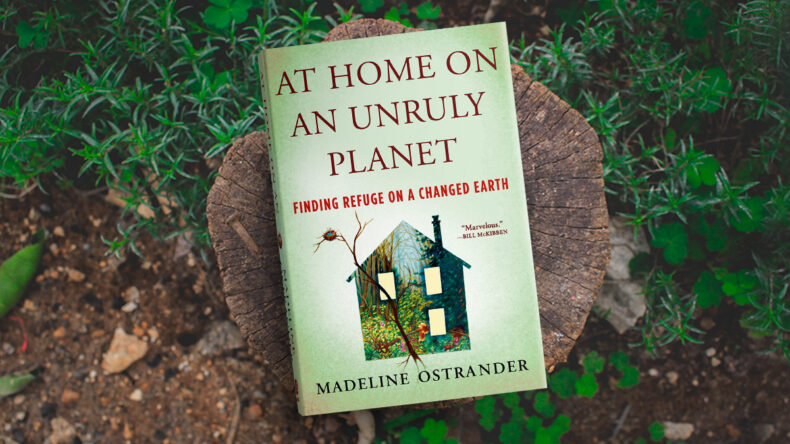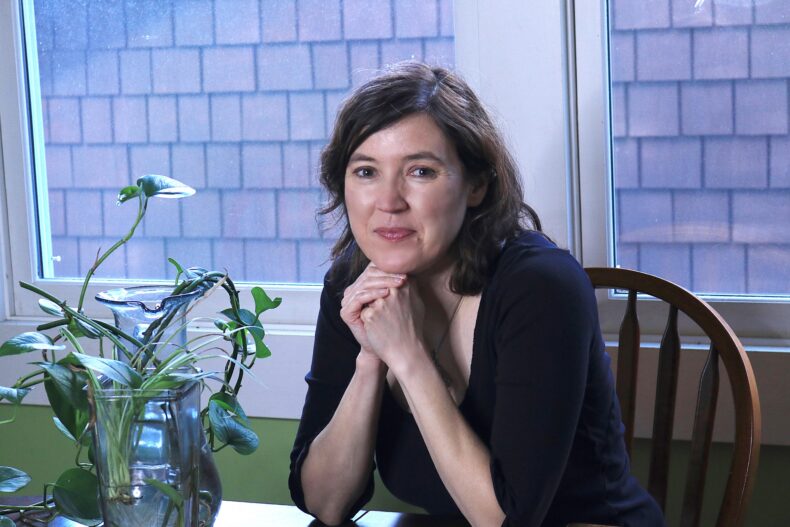
Madeline Ostrander is a passionate and talented science journalist and a good friend. Her must-read book At Home on an Unruly Planet: Finding Refuge on a Changed Earth is on shelves now.
KATE: What initially sparked this project for you?
MADELINE: Like most people who’ve been writing about climate change for a long time, I’ve dealt with a long sense of frustration about how difficult it is for people to grasp the subject, how divisive it’s been, and how even people who understood the concept didn’t seem to understand why it was urgent or what it had to do with their lives. I was always searching for ways to convey that. Then I edited an issue of YES! magazine about resilience and started doing some reporting in the Bay Area with environmental justice groups. I noticed that those groups talked in a very tangible way about how climate policy and climate change were going to affect their communities—What will this mean for us? Will our communities and our people be left out?—and this created a much more concrete way of talking about it. They also asked questions like How can we build our own resilience? How can we think about resilience in our own neighborhoods and cities, the places where we live?
It was so refreshing to me, because for a long time, climate was talked about in very big, abstract terms. Even the policies and solutions were abstract. And those solutions are an important piece of the puzzle, but they’re not the only piece. People need to understand what it all means at a scale that seems relevant to their lives.
I began doing more reporting in communities. I felt like telling local, personal stories made it tangible for people so they could see it. Over time, I arrived at this idea of framing the book around home as a metaphor, as a way to appeal to people’s feelings and values and a sense of immediacy. Home is the physical place you live, but it’s also a relationship you have with the world around you. It’s the way you create a sense of safety out of the world around you. As those surroundings become less predictable and we have more storms and wildfires and other climate impacts, we have to rethink how we live, how we build our homes, and how we create our communities.
Kate: Who is your ideal reader and what would you like them to take away from this book?
Madeline: The Yale Program on Climate Change Communication has these six categories of feelings about climate change, ranging from “Dismissive” to “Alarmed.” That’s the category that cares the most, and that category keeps getting bigger. [Kate’s note: as of this writing, Yale reports that the “Alarmed” represent 33% of the U.S. population.] Many people in that category feel powerless and terrified, like they can’t envision how to go forward. I wanted to give people stories that would help them see how other people are moving forward and thinking about ways to cope and adapt. And so then [those readers] might find a way to get involved in their community and help create solutions that were immediate to them.
I just got an email from an environmental ecologist who said that [he appreciated the book because] it confronts emotions and that, as a scientist, he doesn’t always give himself a chance to really feel his feelings about what’s happening with the climate crisis. He said that spending time in the pages of the book gave him permission to do that.
Kate: I know how much we both love the art on your book cover (by LWON’s own Sarah Gilman!). Can you tell me again the story of how that happened?
Madeline: I knew Sarah well and was pretty familiar with her art. I loved the surrealist quality of it and the way she mixed human and natural elements. She describes her art as “things made of other things,” often natural things made of human things, or vice versa. When I was thinking about the book and the kind of art that might help it make sense to people, Sarah’s art really appealed to me as a way to express the tension between our human relationships with nature.
I approached my publisher and said, “I really think you should ask Sarah if she’d be able to do some art for the cover.” I honestly wasn’t sure what they’d think of the idea, but they went for it. She did some concepts and some sketches and we settled on an image of this really lovely house that has a forest inside it. I love it because it’s messy and unruly, as the title says, and there’s a lot of complex things happening inside it, and I also want to walk into this picture and go live inside that forest. It does a lot to convey what the book is about without making it scary.
Kate: What was the fact-checking process like for this book?
Madeline: Fact-checking was incredibly important for me, particularly because I was writing about communities that are often marginalized. I was concerned about both the factual accuracy of those passages and a kind of cultural accuracy. I pushed my publisher and they generously agreed to hire two sensitivity readers. One person read all the sections on Alaska. That sensitivity reader for those chapters is Yup’ik, and I was really grateful to have her. I had a second sensitivity reader who was more attuned to issues in communities of color, especially Black communities. She also marked a lot of questions about things like ableism, which is important to me and something I’m trying to develop more awareness about as a writer.
For the rest of the fact-checking, I divided the book into three sections and hired three different people to comb through everything. I also checked big sections myself against my notebooks, photographs, and recordings. Was that person really wearing a blue shirt? Does that plant I named actually grow in the Pacific Northwest? All of those things had to be checked. It was quite a process, but I’m grateful I was able to do it. Most publishers don’t have internal fact-checking processes, so you have to figure out how to squeeze it into the publishing and editing process, which is challenging.

Kate: Was there one moment or conversation during the reporting of this book that gave you the most hope?
Madeline: A lot of people in this book gave me hope. I will point out that there are a lot of women in this book. At one point, I almost wondered if there were too many women, because I wanted to make sure that the book was really representational. Then I realized that I was writing about community and the kinds of people who bring communities together, and, for a lot of reasons, the work of building community resilience is done by women. Really strong, powerful, brilliant women.
A couple of the women who stand out to me in the book are Carlene Andrews, a wildland firefighter who was, for a number of years, the mayor of her small town. She’s led this incredible recovery effort across central Washington that’s become a model for how communities can recover and rebuild after wildfire. She’s just one of the most courageous and compassionate people I’ve ever met. Truly a shining light for how one can walk through a crisis, come out the other side, and find meaning and community in it.
Another person is Doria Robinson, who just won a seat on the city council in Richmond, California. She runs an urban farming organization and is constantly thinking about how to lift people up around her and how to reimagine community. Richmond is very much dominated by an oil refinery. She’s working with her community to reimagine the city as something more sustainable, as a place that can grow something else. She’s always really inspired me.
Kate: What do you love most about your home (whatever “home” means to you)?
Madeline: I’ve moved around a lot. In a funny way, I wonder if the reason I wrote the book is that I have my own search for rootedness, my own quest to figure out where I belong. That feeling is surely complicated by the fact that the world is changing really rapidly. I live in Seattle now, and I do think the Pacific Northwest is really extraordinary, both ecologically and socially. This is an incredibly beautiful region with a lot of wilderness. And people have a very strong sense of place here. People really care about things like salmon conservation and water pollution cleanup. There are a lot of powerful advocates for this region trying to address climate change.
There was a proposal a few years ago to try to build a number of coal export terminals around the region, and nearly all of those projects failed because there was huge opposition from all around the region organized by tribes, communities, and environmental activists. That response speaks to how much people care about this place. I think the fight for climate change is a fight to protect what we love.